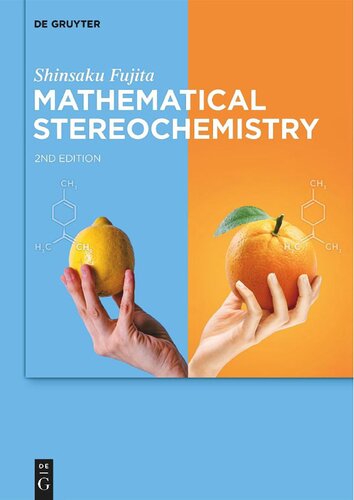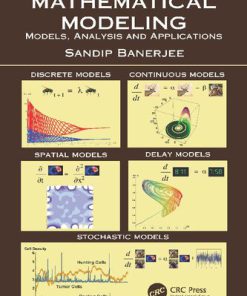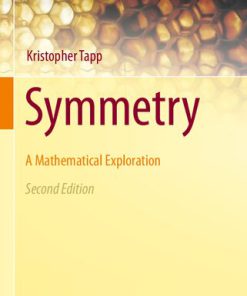Mathematical Stereochemistry 2nd Edition by Shinsaku Fujita 3110728338 9783110728330
$50.00 Original price was: $50.00.$25.00Current price is: $25.00.
Mathematical Stereochemistry 2nd Edition by Shinsaku Fujita – Ebook PDF Instant Download/Delivery: 3110728338, 9783110728330
Full download Mathematical Stereochemistry 2nd Edition after payment

Product details:
ISBN 10: 3110728338
ISBN 13: 9783110728330
Author: Shinsaku Fujita
Chirality and stereogenicity are closely related concepts and their differentiation and description is still a challenge in chemoinformatics. In his 2015 book, Fujita developed a new stereoisogram approach that provided theoretical framework for mathematical aspects of modern stereochemistry. This new edition includes a new chapter on Computer-Oriented Representations developed by the author based on Groups, Algorithms, Programming (GAP) system.
Mathematical Stereochemistry 2nd Table of contents:
1 Introduction
1.1 Two-Dimensional versus Three-Dimensional Structures
1.1.1 Two-Dimensional Structures in Early History of Organic Chemistry
1.1.2 Three-Dimensional Structures After Beginning of Stereochemistry
1.1.3 Arbitrary Switching Between 2D-Based and 3D-Based Concepts
1.2 Problematic Methodology for Categorizing Isomers and Stereoisomers
1.2.1 Same or Different
1.2.2 Dual Definition of Isomers
1.2.3 Positional Isomers as a Kind of Constitutional Isomers
1.3 Problematic Methodology for Categorizing Enantiomers and Diastereomers
1.3.1 Enantiomers
1.3.2 Diastereomers
1.3.3 Chirality and Stereogenicity
1.4 Total Misleading Features of the Traditional Terminology on Isomers
1.4.1 Total Misleading Flowcharts
1.4.2 Another Flowchart With Partial Solutions
1.4.3 More Promising Way
1.5 Isomer Numbers
1.5.1 Combinatorial Enumeration as 2D Structures
1.5.2 Importance of the Proligand-Promolecule Model
1.5.3 Combinatorial Enumeration as 3D Structures
1.6 Stereoisograms
1.6.1 Stereoisograms as Diagrammatic Expressions of RS-Stereoisomeric Groups
1.6.2 Theoretical Foundations and Group Hierarchy
1.6.3 Avoidance of Misleading Standpoints of R/S-Stereodescriptors
1.6.4 Avoidance of Misleading Standpoints of pro-R/pro-S-Descriptors
1.6.5 Global Symmetries and Local Symmetries
1.6.6 Enumeration under RS-Stereoisomeric Groups
1.7 Aims of Mathematical Stereochemistry
2 Classification of Isomers
2.1 Equivalence Relationships of Various Levels of Isomerism
2.1.1 Equivalence Relationships and Equivalence Classes
2.1.2 Enantiomers, Stereoisomers, and Isomers
2.1.3 Inequivalence Relationships
2.1.4 Isoskeletomers as a Missing Link for Consistent Terminology
2.1.5 Constitutionally-Anisomeric Relationships vs. Constitutionally-Isomeric Relationships
2.2 Revised Flowchart for Categorizing Isomers
2.2.1 Design of a Revised Flowchart for Categorizing Isomers
2.2.2 Illustrative Examples
2.2.3 Restriction of the Domain of Isomerism
2.2.4 Harmonization of 3D-Based Concepts with 2D-Based Concepts
3 Point-Group Symmetry
3.1 Stereoskeletons and the Proligand-Promolecule Model
3.1.1 Configuration and Conformation
3.1.2 The Proligand-Promolecule Model Based on Stereoskeletons
3.2 Point Groups for Characterizing Geometric Symmetry of Molecular Entity
3.2.1 Symmetry Axes and Symmetry Operations
3.2.2 Construction of Point Groups
3.2.3 Subgroups of a Point Group
3.2.4 Maximum Chiral Subgroup of a Point Group
3.2.5 Global and Local Point-Group Symmetries
3.3 Point-Group Symmetries of Various Stereoskeletons
3.3.1 Stereoskeletons of Ligancy 4
3.3.2 Stereoskeletons of Ligancy 6
3.3.3 Stereoskeletons of Ligancy 8
3.3.4 Stereoskeletons Having Two or More Orbits
3.4 Point-Group Symmetries of (Pro)molecules
3.4.1 Derivation of Molecules from a Stereoskeleton via Promolecules
3.4.2 Orbits in Molecules and Promolecules Derived from Stereoskeletons
3.4.3 The SCR Notation
3.4.4 Site Symmetries vs. Coset Representations for Symmetry Notations
4 Sphericities of Orbits and Prochirality
4.1 Sphericities of Orbits
4.1.1 Orbits of Equivalent Proligands
4.1.2 Three Kinds of Sphericities
4.1.3 Chirality Fittingness for Three Modes of Accommodation
4.2 Prochirality
4.2.1 Confusion on the Term ‘Prochirality’
4.2.2 Prochirality as a Geometric Concept
4.2.3 Enantiospheric Orbits vs. Enantiotopic Relationships
4.2.4 Chirogenic Sites in an Enantiospheric Orbit
4.2.5 Prochirality Concerning Chiral Proligands in Isolation
4.2.6 Global Prochirality and Local Prochirality
5 Foundations of Enumeration Under Point Groups
5.1 Orbits Governed by Coset Representations
5.1.1 Coset Representations
5.1.2 Mark Tables
5.1.3 Multiplicities of Orbits
5.2 Subduction of Coset Representations
5.2.1 Subduced Representations
5.2.2 Unit Subduced Cylce Indices (USCIs)
6 Symmetry-Itemized Enumeration Under Point Groups
6.1 Fujita’s USCI Approach
6.1.1 USCI-CFs for Itemized Enumeration
6.1.2 Subduced Cycle Indices for Itemized Enumeration
6.2 The FPM Method of Fujita’s USCI Approach
6.2.1 Fixed-Point Vectors (FPVs) and Multiplicity Vectors (MVs)
6.2.2 Fixed-Point Matrices (FPMs) and Isomer-Counting Matrices (ICMs)
6.2.3 Practices of the FPM Method
6.3 The PCI Method of Fujita’s USCI Approach
6.3.1 Partial Cycle Indices With Chirality Fittingness (PCI-CFs)
6.3.2 Partial Cycle Indices Without Chirality Fittingness (PCIs)
6.3.3 Practices of the PCI Method
6.4 Other Methods of Fujita’s USCI Approach
6.4.1 The Elementary-Superposition Method
6.4.2 The Partial-Superposition Method
6.5 Applications of Fujita’s USCI Approach
6.5.1 Enumeration of Flexible Molecules
6.5.2 Enumeration of Molecules Interesting Stereochemically
6.5.3 Enumeration of Inorganic Complexes
6.5.4 Enumeration of Organic Reactions
7 Gross Enumeration Under Point Groups
7.1 Counting Orbits
7.2 Pólya’s Theorem of Counting
7.3 Fujita’s Proligand Method of Counting
7.3.1 Sphericities of Cycles
7.3.2 Products of Sphericity Indices
7.3.3 Practices of Fujita’s Proligand Method
7.3.4 Enumeration of Achiral and Chiral Promolecules
8 Enumeration of Alkanes as 3D Structures
8.1 Surveys With Historical Comments
8.2 Enumeration of Alkyl Ligands as 3D Planted Trees
8.2.1 Enumeration of Methyl Proligands as Planted Promolecules
8.2.2 Recursive Enumeration of Alkyl ligands as Planted Promolecules
8.2.3 Functional Equations for Recursive Enumeration of Alkyl ligands
8.2.4 Achiral Alkyl Ligands and Pairs of Enantiomeric Alkyl Ligands
8.3 Enumeration of Alkyl Ligands as Planted Trees
8.3.1 Alkyl Ligands or Monosubstituted Alkanes as Graphs
8.3.2 3D Structures vs. Graphs for Characterizing Alkyl Ligands or Monosubstituted Alkanes
8.4 Enumeration of Alkanes (3D-Trees) as 3D-Structural Isomers
8.4.1 Alkanes as Centroidal and Bicentroidal 3D-Trees
8.4.2 Enumeration of Centroidal Alkanes (3D-Trees) as 3D-Structural Isomers
8.4.3 Enumeration of Bicentroidal Alkanes (3D-Trees) as 3D-Structural Isomers
8.4.4 Total Enumeration of Alkanes as 3D-Trees
8.5 Enumeration of Alkanes (3D-Trees) as Steric Isomers
8.5.1 Centroidal Alkanes (3D-Trees) as Steric Isomers
8.5.2 Bicentroidal Alkanes (3D-Trees) as Steric Isomers
8.5.3 Total Enumeration of Alkanes (3D-Trees) as Steric Isomers
8.6 Enumeration of Alkanes (Trees) as Graphs or Constitutional Isomers
8.6.1 Alkanes as Centroidal and Bicentroidal Trees
8.6.2 Enumeration of Centroidal Alkanes (Trees) as Constitutional Isomers
8.6.3 Enumeration of Bicentroidal Alkanes (Trees) as Constitutional Isomers
8.6.4 Total Enumeration of Alkanes (Trees) as Graphs or Constitutional Isomers
9 Permutation-Group Symmetry
9.1 Historical Comments
9.2 Permutation Groups
9.2.1 Permutation Groups as Subgroups of Symmetric Groups
9.2.2 Permutations vs. Reflections
9.3 RS-Permutation Groups
9.3.1 RS-Permutations and RS-Diastereomeric Relationships
9.3.2 RS-Permutation Groups vs. Point Groups
9.3.3 Formulation of RS-Permutation Groups
9.3.4 Action of RS-Permutation Groups
9.3.5 Misleading Features of the Conventional Terminology
9.4 RS-Permutation Groups for Skeletons of Ligancy 4
9.4.1 RS-Permutation Group for a Tetrahedral Skeleton
9.4.2 RS-Permutation Group for an Allene Skeleton
9.4.3 RS-Permutation Group for an Ethylene Skeleton
10 Stereoisograms and RS-Stereoisomers
10.1 Stereoisograms as Integrated Diagrammatic Expressions
10.1.1 Elementary Stereoisograms of Skeletons with Position Numbering
10.1.2 Stereoisograms Based on Elementary Stereoisograms
10.2 Enumeration Under RS-Stereoisomeric Groups
10.2.1 Subgroups of the RS-Stereoisomeric Group C3vσ̃Î
10.2.2 Coset Representations
10.2.3 Mark Table and its Inverse
10.2.4 Subduction for RS-Stereoisomeric Groups
10.2.5 USCI-CFs for RS-Stereoisomeric Groups
10.2.6 SCI-CFs for RS-Stereoisomeric Groups
10.2.7 The PCI Method for RS-Stereoisomeric Groups
10.2.8 Type-Itemized Enumeration by the PCI Method
10.2.9 Gross Enumeration Under RS-Stereoisomeric Groups
10.3 Comparison with Enumeration Under Subgroups
10.3.1 Comparison with Enumeration Under Point Groups
10.3.2 Comparison with Enumeration Under RS-Permutation Groups
10.3.3 Comparison with Enumeration Under Maximum-Chiral Point Subgroups
10.4 RS-Stereoisomers as Intermediate Concepts
11 Stereoisograms for Tetrahedral Derivatives
11.1 RS-Stereoisomeric Group Tdσ˜I^ and Elementary Stereoisogram
11.2 Stereoisograms of Five Types for Tetrahedral Derivatives
11.2.1 Type-I Stereoisograms of Tetrahedral Derivatives
11.2.2 Type-II Stereoisograms of Tetrahedral Derivatives
11.2.3 Type-III Stereoisograms of Tetrahedral Derivatives
11.2.4 Type-IV Stereoisograms of Tetrahedral Derivatives
11.2.5 Type-V Stereoisograms of Tetrahedral Derivatives
11.3 Enumeration Under the RS-Stereoisomeric Group Tdσ˜l^
11.3.1 Non-Redundant Set of Subgroups and Five Types of Subgroups
11.3.2 Subduction of Coset Representations
11.3.3 The PCI Method for the RS-Stereoisomeric Group Tdσ̃Î
11.3.4 Type-Itemized Enumeration by the PCI Method
11.4 Comparison with Enumeration Under Subsymmetries
11.4.1 Enumeration of Tetrahedral Promolecules Under the Point-Group Symmetry
11.4.2 Enumeration of Tetrahedral Promolecules Under the RS-Permutation-Group Symmetry
11.4.3 Comparison with Enumeration Under Maximum-Chiral Point Subgroups
11.4.4 Confusion Between the Point-Group Symmetry and the RS-Permutation-Group Symmetry
12 Stereoisograms for Allene Derivatives
12.1 RS-Stereoisomeric Group D2dσ^I^ and Elementary Stereoisogram
12.2 Stereoisograms of Five Types for Allene Derivatives
12.2.1 Type-I Stereoisograms of Allene Derivatives
12.2.2 Type-II Stereoisograms of Allene Derivatives
12.2.3 Type-III Stereoisograms of Allene Derivatives
12.2.4 Type-IV Stereoisograms of Allene Derivatives
12.2.5 Type-V Stereoisograms of Allene Derivatives
12.3 Enumeration Under the RS-Stereoisomeric Group D2dσ^
12.3.1 Non-Redundant Set of Subgroups and Five Types of Subgroups
12.3.2 Subduction of Coset Representations
12.3.3 The PCI Method for the RS-Stereoisomeric Group D2dσ̃Î
12.3.4 Type-Itemized Enumeration by the PCI Method
12.4 Comparison with Enumeration Under Subsymmetries
12.4.1 Enumeration of Allene Promolecules Under the Point-Group Symmetry
12.4.2 Enumeration of Allene Promolecules Under the RS-Permutation-Group Symmetry
13 Combined-Permutation Representations (CPRs)
13.1 Chemical Compounds as Graphs vs. as 3D Structures
13.2 Combined-Permutation Representations (CPRs) as Computer-Oriented Representations of Point Groups
13.2.1 Coset Representations
13.2.2 Mirror-Permutation Representations
13.2.3 Combined Representations and The Corresponding Groups
13.2.4 Partition into Conjugacy Classes
13.3 Correspondence Between Oh-Skeletons
13.3.1 Combined-Permutation Groups for Oh-Skeletons
13.3.2 Isomorphism between Combined-Permutation Groups for Oh-Skeletons
13.4 Calculation of CI-CFs
13.4.1 Products of Sphericity Indices
13.4.2 Definition of CI-CFs
13.4.3 Functions for Calculating CI-CFs
13.4.4 Practices of Calculation of CI-CFs
13.5 Combinatorial Enumeration
13.5.1 Generating Functions Derived From CI-CFs
13.5.2 Selective Calculation of Coefficients of Generating Functions
13.5.3 Merits of the Present Procedure in Enumeration by Fujita’s Proligand Method
13.6 Conclusive Remarks on Applicability of Combined-Permutation Representations
13.7 Appendix A. Source Code of CICFgenCC.gapfunc for Calculating CI-CFs
13.8 Appendix B. Source Code of Oh-Enum-cube.gap for Enumerating Cubane Derivatives
14 Stereochemical Nomenclature
14.1 Absolute Configuration
14.1.1 Single Pair of Attributes ‘Chirality/Achirality’ in Modern Stereochemistry
14.1.2 Three Pairs of Attributes in Fujita’s Stereoisogram Approach
14.1.3 Three Aspects of Absolute Configuration
14.2 Quadruplets of RS-Stereoisomers as Equivalence Classes
14.2.1 Three Types of Pairwise Relationships in a Quadruplet of RS-Stereoisomers
14.2.2 Formulation of Stereoisograms as Quadruplets of RS-Stereoisomers
14.3 Inner Structures of Promolecules
14.3.1 Inner Structures of RS-Stereogenic Promolecules
14.3.2 Inner Structures of RS-Astereogenic Promolecules
14.4 Assignment of Stereochemical Nomenclature
14.4.1 Single Criterion for Giving RS-Stereodescriptors
14.4.2 RS-Diastereomers: the CIP Priority System
14.4.3 R/S-Stereodescriptors and Stereoisograms
14.4.4 Chirality Faithfulness
14.4.5 Stereochemical Notations for Other Skeletons
15 Pro-RS-Stereogenicity Based on Orbits
15.1 Prochirality vs. Pro-RS-Stereogenicity
15.1.1 Prochirality as a Geometric Concept
15.1.2 Pro-RS-Stereogenicity as a Stereoisomeric Concept
15.1.3 Prochirality and Pro-RS-Stereogenicity for Tetrahedral Derivatives
15.2 Orbits under RS-Permutation Groups
15.2.1 RS-Tropicity
15.2.2 Pro-RS-Stereogenicity as a Stereoisomeric Concept
15.3 pro-R/pro-S-Descriptors
15.3.1 RS-Diastereotopic Relationships
15.3.2 Single Criterion for Giving pro-R/pro-S-descriptors
15.3.3 Probe Stereoisograms for Assining pro-R/pro-S-Descriptors
15.3.4 Misleading Interpretation of ‘Prochirality’ in Modern Stereochemistry
15.4 Pro-RS-Stereogenicity Distinct From Prochirality
15.4.1 Simultaneity of Prochirality and Pro-RS-Stereogenicity in a Type-IV Promolecule
15.4.2 Coincidence of Prochirality and Pro-RS-stereogenicity
15.4.3 Prochiral (but Already RS-Stereogenic) Promolecules
15.5 Pro-RS-Stereogenicity for pro-R/pro-S-Descriptors
Supplementary Remark: Mathematical Stereochemistry and STEM
16 Perspectives
16.1 Enumeration of Highly Symmetric Molecules
16.2 Interaction of Orbits of Different Kinds
16.3 Correlation Diagrams of Stereoisograms
16.4 Group Hierarchy
16.5 Combined-Permutation Representations (CPRs) and the GAP System
16.6 Non-Rigid Molecules and Conformations
16.7 Interdisciplinary Nature of Mathematical Stereochemistry
16.7.1 Mathematical and Stereochemical Barriers In Practical Levels
16.7.2 Mathematical and Stereochemical Barriers In Conceptual Levels
16.8 Stereochemistry and Stereoisomerism. Theoretical Foundations
16.9 Hints for Further Investigations
Supplementary Remark: for Chemical Equations and for Methematical Equations
Index
Symbols
People also search for Mathematical Stereochemistry 2nd:
2n rule stereoisomers
2n stereoisomers
stereochemistry problems and solutions pdf
stereoisomers 2n rule
Tags:
Shinsaku Fujita,Mathematical,Stereochemistry
You may also like…
Mathematics - Applied Mathematics
Chemistry - Organic Chemistry
Mathematics - Analysis
Uncategorized
Mathematical Stereochemistry 2nd Edition by Shinsaku Fujita ISBN 9783110728231 3110728230
Education Studies & Teaching - Teaching & Teacher Training
Mathematics - Others
Chemistry - Analytical Chemistry
Stereochemistry: A Three-Dimensional Insight 1st Edition BY Anil, Mohammed 9780128210628 0128210621











